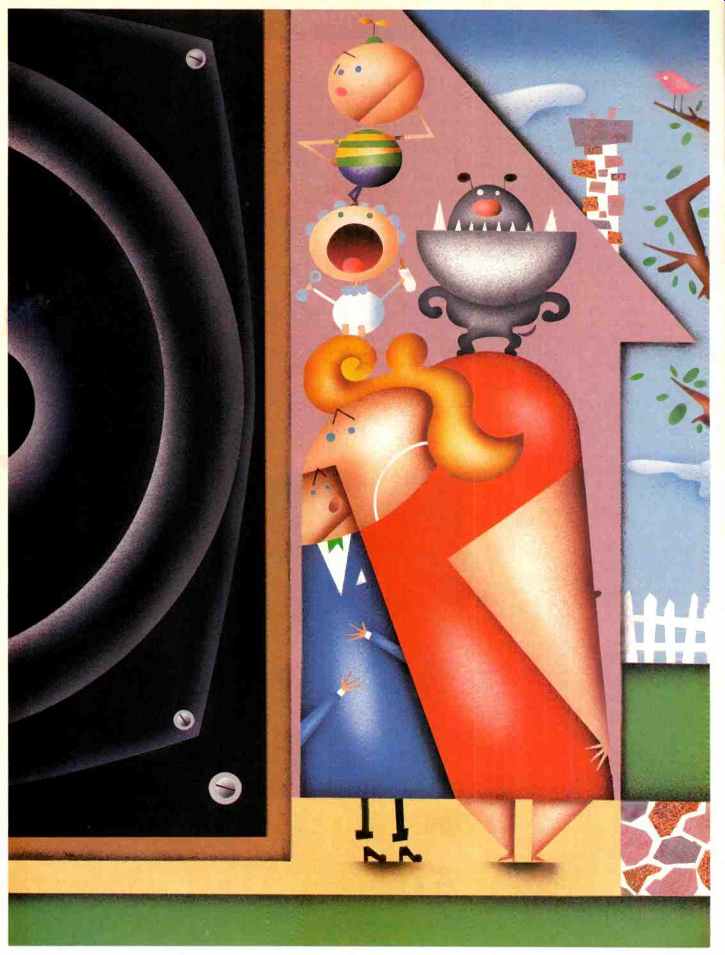
By: JAMES S. SHERWIN
The design, measurement, and subjective evaluation of large subwoofers capable of complementing the dynamic impact of efficient horn loudspeaker systems in the home has intrigued me for several years. While I recognize that few would choose to live with a pair of sub woofers when each occupies 32 cubic feet of living-room space, many would appreciate the sonic results. I have lived with a JBL Hartsfield corner horn, possibly the most graceful of loudspeaker boxes, and still use a 60-cubic-foot compound bass horn, but neither has had the bass extension below 20 Hz realized by these subwoofers.
I've never built concrete exponential horns extending outside my living room nor met anyone who has, but I did once buy an 11-rank pipe organ (653 pipes) to install in my home, so maybe that qualifies me as certifiable.
I recently fixed upon the idea of extending system response another octave below the 40 Hz of my existing horn system as well as realizing improved time coherence by eliminating the folded horn. Even I deem straight bass horns with good 20-Hz response to be impractical, hence my decision to use vented boxes for a subwoofer design. The first step in the transition was to design, build, test, and audition these subwoofers. The next step will be to abandon the large horn for a more compact mid-bass short horn working above 80 Hz.
The desired results have been achieved: The bass extension is significant to below 15 Hz and is flatter than expected, no bass-boost or peaking networks are necessary, and each of the two subwoofers is capable of producing 96 dB SPL at 1 meter for 1 watt input. Their efficiency is only 2.6%, compared to 10 times that for the remainder of the horn-loaded system, but it is nice to know that the full impact of a bass drum can now be reproduced in my living room. These sub woofers do wonders with source material such as pipe organ, large bass drum, synthesizer, thunder, and even cannon shots. Telarc's Time Warp (CD-80106) is stunning with this system, but there is another, more important improvement I will discuss later.
The Quest for All of the Music
Much attention has been given to extending loudspeaker response toward and even beyond 20 kHz, where any real improvement may possibly come from an attendant approach to a linear-phase system rather than from the reproduction of any musical harmonic content in the nether reaches.
This attention may be well deserved and is certainly less space consuming than an extension downward to 16 Hz.
However, when musical response is extended upward without similar extension downward, the balance of the music structure may suffer. I cannot guarantee this to be the case but have observed that the bass at concerts is much more apparent than in reproduced music, whereas the highs seem similar.
Commercially available subwoofers were passed over because few, if any, can produce the desired level of clean low bass, and most give up low bass response and/or utilize active equalization to gain bass extension without resorting to large cabinet sizes. While many available units no doubt produce results superior to what may be achieved with conventional loudspeaker systems, I decided on larger boxes for improved efficiency that would enable my system to extract more dynamic impact from the music source. It may be safe to limit the discussion of required SPL to that expected with orchestral instruments, drums, and synthesizers because reproducing cannon, thunder, and other environmental sounds at realistic levels is probably out of the question. Assumptions of a 90-dB SPL average listening level for symphonic music and 20-dB peak-to average levels have often been used in determining peak required SPL for effective music reproduction. Rock music is typically played at higher average levels but normally exhibits a lower peak-to-average ratio. Using the above values, music peaks of 110 dB SPL must be reproduced at the listening position. The subwoofer handles most of the power because the orchestral bass drum creates the highest of these peaks at 40 to 60 Hz. Measurements made on one-octave pink noise centered at 31.6 Hz, at the 5-meter listening position in a moderately large living room, show the SPL to be 10 dB below that at 1 meter from the sub woofer. The net result is that the sub woofer is required to generate 120 dB peak SPL at 1 meter. Fielder and Benjamin [1] found that, on some CDs, environmental, synthesizer, and pipe organ sounds would extend the required frequency range to as low as 13 or even 10 Hz (see Table I). It seems likely, then, that the greatest music dynamics can be reproduced only with large subwoofers. Whether this is worth sacrificing 32 to 64 cubic feet of living-room space is up to the individual. This writer is pleased with the trade-off, but you may remember that I am probably certifiable.
The Design
Ground rules for this design were: High efficiency to maintain music dynamics, easily equalized response to 20 Hz, and real but flexible limits on system size.
Thiele and Small [2, 3, and 4] have shown that high efficiency is obtained only with drivers of large cone volume displacement placed in large boxes, so this was the starting point. While other drivers may have been suitable, the JBL 2235 and 2245 15- and 18-inch drivers were the final candidates.
The 2245 18-inch driver was initially selected because of its 2.1% half space efficiency, which gives it a power output of 95 dB SPL for 1 watt at 1 meter. It is important to recognize that this SPL and efficiency are ratings fog the flat-band response above 100 Hz and are not necessarily representative of efficiency and output in the sub-bass region between 20 and 100 Hz, where box volume and tuning greatly affect system efficiency. The final choice was two 2235 15-inch drivers per box (see Table II). Because using two drivers per box theoretically doubles their efficiencies, the paired 15 inch drivers operate at 2.6% efficiency with a sensitivity of 96 dB SPL. The next step was to select an alignment from Thiele's tables [5] and do some computer modeling to determine the system response for various alignments, box tuned frequencies, and box volumes. It was known at the beginning that at least four 15-inch cones were needed to maintain low distortion and that a large box was needed to achieve high efficiency.
With this in mind, several possible alignments were modeled before I selected the fourth-order Butterworth (B4) alignment with box and cone resonance coincident at 20 Hz ( Table III). In this alignment, the net internal cabinet volume is 0.707 times speaker Vas (the volume of air having the same acoustic compliance as the driver suspension). This requirement ruled out the JBL 2245 drivers, as box volume for two 18-inch drivers would have been 41 cubic feet, whereas it is only 22.9 cubic feet for the two 15-inch drivers. Computer modeling also showed that the system response would be slightly smoother, and cone excursion limits would be slightly less stringent between 20 and 25 Hz, with the 2235s than with the 2245s. Accordingly, the ultimate choice was a pair of 2235 drivers in a cabinet having a volume of 22.9 cubic feet. The same response, but with lower efficiency, could be achieved with one 2235 in a cabinet of 11.45 cubic feet.
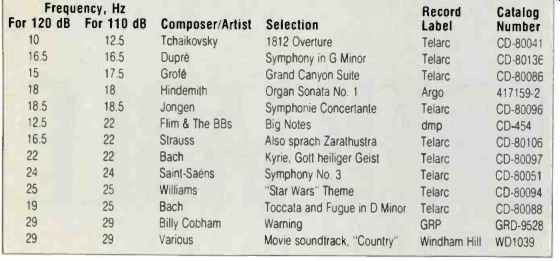
Table I--Compact Discs with audible components below 32 Hz. (From Fielder
and Benjamin.) Computer modeling [6] of the final design indicates response
to be -2 dB at 75 Hz and -8.8 dB at 20 Hz.
This meets design criteria, as it can be easily corrected with a simple tone control hinged at 100 Hz. Other specifics in Table IV indicate that each sub woofer can produce 115.5 dB SPL at 1 meter at 20 Hz and 121.6 dB SPL at 100 Hz with a 300-watt input. Actual room response is considerably better than this at the extreme low end, due to bass gain of the room [1 and 7], as will be seen later. The calculated displacement-limited power input is 293 watts maximum at 30 Hz. The thermal-limit numbers are for long-term operation and may be considerably surpassed over most of the passband to produce much greater speaker output for brief moments. For example, if thermal limits are conveniently ignored, the Table IV data in parentheses indicates the displacement-limited average power, which should not be exceeded.
The final design is a box having an internal volume of 29 cubic feet, or a net internal volume of 22.9 cubic feet after deducting 3.1 cubic feet for the ducted port, 0.4 cubic foot for the two drivers, and 2.6 cubic feet for the bracing. Overall room volume displaced is 32 cubic feet, including the cabinet's base. The phantom views of box construction in Fig. 1 show the preferred off-center driver placement, symmetrical port placement for equal mutual coupling between drivers and port, internal proportions of 0.8 x 1 x 1.25 [5], legless design for improved imaging to the floor [7], and robust panel bracing.
===========
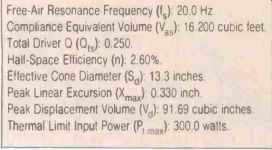
Table II--Driver parameters for JBL 2235 15-inch woofers.
Free-Air Resonance Frequency (fs): 20.0 Hz.
Compliance Equivalent Volume (Vas): 16.200 cubic feet.
Total Driver O (Ors): 0.250. Half-Space Efficiency (n): 2.60%.
Effective Cone Diameter (Sd): 13.3 inches.
Peak Linear Excursion (Xmax): 0.330 inch.
Peak Displacement Volume (Vd): 91.69 cubic inches.
Thermal Limit Input Power (Pr max): 300.0 watts.
=============
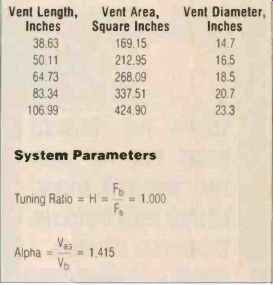
Table III Box and system parameters.
Box Parameters Net Internal Volume (Vb): 22.900 cubic feet.
Helmholtz Resonance Frequency (f1): 20.0 Hz.
Box Leakage O (0'): 3.0. Minimum Vent Area: 169.2 cubic inches.
==========
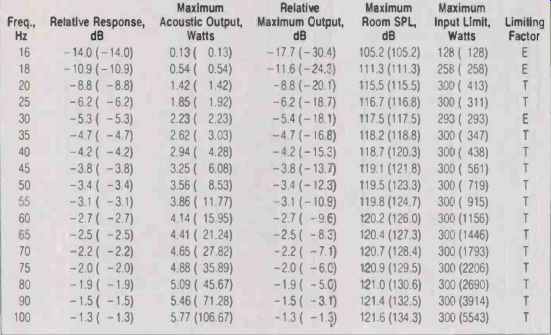
above: Table IV Calculated free-field system performance. Figures in parentheses
are for short-term performance, set by excursion limits. Other figures, for
long-term performance, are governed by thermal limits (T) or excursion limas
(E), as shown in last column.
=======
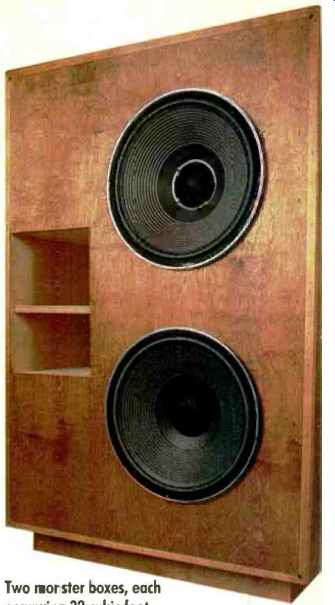
Two monster boxes, each occupying 32 cubic feet, fill the author's
living room with bass that's deep and powerful.
Shocks and Surprises
Seeing the completed cabinets for the first time was somewhat of a shock, as the boxes hadn't looked all that large on paper. Lifting them into the truck was another shock, as they were built of void-free Finnish birch plywood and maple hardwood, internally braced with hemlock and fir. The boxes looked-even larger in the listening room, so only one was installed initially, lessening the shock to my wife. A month later, the other box took its place on the other side of the room.
Initial listening was done with a sub woofer amplifier rated to deliver 325 watts per channel into 4 ohms. Although the system was then adequate for most musical information (including pipe organ reproduction), CDs which contained thunder or cannon shots, and Telarc's Time Warp, caused amplifier clipping. I can assure you that amplifier clipping into these subwoofers is quite apparent-and somewhat frightening when you consider the longevity of four expensive drivers. Amplifier clipping does not necessarily mean that the amplifier is delivering maximum power into the speakers because speaker impedance varies with frequency, but there seemed no choice but to invest in a higher powered amplifier. The one selected is rated at 800 watts per channel into 4 ohms. More power would be even more suitable because it is still necessary to exercise care when demonstrating interesting source material. Some source material contains significant stereo information below 80 Hz; this can cause the channel with the higher bass levels to be driven into clipping while some of the other channel's power capacity is unused. To best utilize available amplifier power, it is desirable to sum the sub woofer signals by bridging or other means. This is valid because the ear has little directional sensitivity at very low frequencies.
Measurements
As I firmly believe in measurements as well as subjective evaluation, I listened for but a few days before beginning a series of tests. The measurements made were: Complex impedance, in a search for unwanted cabinet or cone resonances; impedance magnitude, to verify box, cone, and coupled-system resonances; response to single-frequency sweeps; both in the room and outside, and harmonic distortion at several power levels. Indoor measurements were near-field, at 1 meter and at the 5-meter listening position. Outdoor measurements were at 1 meter, with the speaker aimed parallel to the outside house wall. I've no access to equipment for TDS measurements, but my swept-frequency network analyzer measurements are adequate for near-field and outdoor work.
The outdoor measurements were made with the speaker standing away from the house, on pavement. The area may be considered free of intruding resonances below 43 Hz but becomes reverberant above this point due to a low wall running parallel to the house.
The outdoor placement provides approximately the same bass gain from the pavement and house wall that exists due to the listening room's floor and rear wall, so outdoor measurements may approximate TDS measurements made inside.
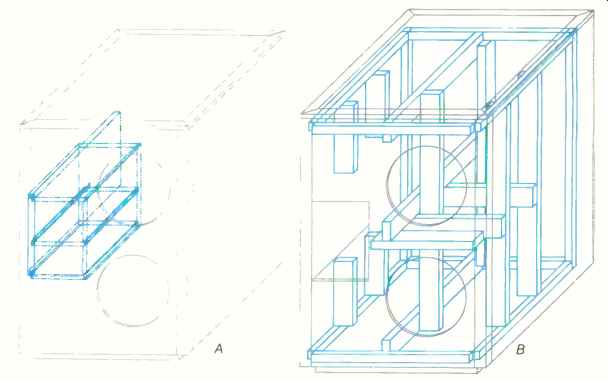
Fig. 1--Composite views, showing port construction (A) and internal bracing
(B).
Perhaps the most pleasant surprise of all is that the outdoor 1-meter swept frequency response of Fig. 2 is flat within about ±0.75 dB from 55 Hz down to 17 Hz and is only about 3.5 and 10 dB down at 15 and 13 Hz, respectively. The departure from my computer-generated predictions is at least partially due to the increased radiation resistance caused by speaker proximity to the pavement; the proximity effect, apparent when a surface is 0.1 wavelength from the driver [7 and 8], increases radiation resistance on the lower driver below 100 Hz and on the upper driver below 50 Hz. Irregularities in the measured response from about 45 Hz up are due to the environment and may be ignored. Inside the listening room, additional bass gain--effective at various frequencies due to proximity of side walls (8, 11, 16, and 28 Hz), ceiling (19 Hz), rear wall (20 Hz), and opposite wall (5 Hz)-is expected to further improve bass response, although the effect should be quite smooth and mild due to my room's size and multi-faceted "L" shape [1]. The effect of this bass gain is to significantly increase loudspeaker efficiency and reduce cone-excursion requirements at low frequencies [1]. Averaging peaks and dips of the near field indoor measurements suggests an essentially flat response to 1 kHz, although there is no intent to Use the subwoofers above 70 to 100 Hz.
The impedance magnitude curve of Fig. 3, showing 9.5- and 31-Hz peaks occurring on either side of the 20-Hz common resonance, is typical of ported-box loudspeakers. The impedance is 4 ohms only from 16 to 19 Hz, between the two peaks, and again from 100 to 300 Hz, so power input calculations based on constant impedance can be misleading. For example, an amplifier rated at 800 watts into 4 ohms, supplying 57V into 4 ohms or more, delivers only 64 watts into 500 ohms, so clipping may occur near the two resonant peaks without driving the speakers to their excursion limits.
It is instructive to plot the power absorbed by the subwoofer from an amplifier rated at 800 watts into 4 ohms and compare it with the calculated excursion-limited peak-power measurements (Fig. 4). The top curve is the excursion-limited power curve, factoring in corrections for the effects of bass gain in the room. This bass gain reduces driver cone displacement to below calculated values; hence higher power is required to drive the cones to their linear excursion limits. The corrected curve indicates that the cones will remain within their linear excursion limits with the full voltage output of the suggested amplifier at all frequencies, thus keeping distortion within acceptable limits over all available operating conditions.
The complex impedance curve (not shown) indicated only two very minor subwoofer resonances, at 125 and 145 Hz; these are also visible in the impedance magnitude curve (Fig. 3). Since the cabinets will be used only below 100 Hz, these resonances (which may be either cone- or box-related) are of only academic interest and have no effect on the reproduced sound.
Second- and third-harmonic distortion components are plotted versus frequency in Fig. 5 for nominal 10- and 100-watt inputs, equivalent to 106 and 116 dB SPL at 1 meter. The levels of the 100-watt curves have been lowered 10 dB for clarity. Each distortion component is commendably low, less than 2% for all frequencies, where each subwoofer is driven by a nominal 10 watts to produce 106 dB SPL at 1 meter.
In any case, the constant-voltage frequency response is flat down to 17 Hz, there are no measurable cabinet resonances in the intended frequency range, and distortion is within acceptable limits over the full operating range of power and frequency. An amp rated at 800 watts per channel allows unclipped listening at full symphonic levels, in a moderately large room, for anything except cannon and thunder.
Technically, the project can be considered a success, but what of the listening experience?
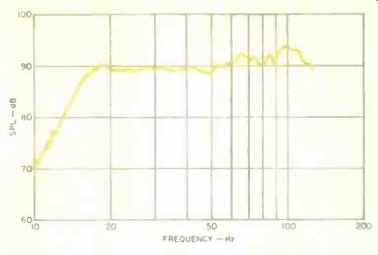
Fig. 2--Frequency response, measured outdoors at 1 meter, for 1 watt input.
Reverberant-field effects caused by a nearby wall become evident at about
40 Hz (13-foot critical dimension); see text.
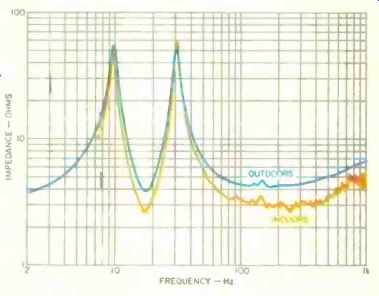
Fig. 3--Magnitude of impedance, measured indoors in a reverberant field
and outdoors in an almost non-reverberant field.
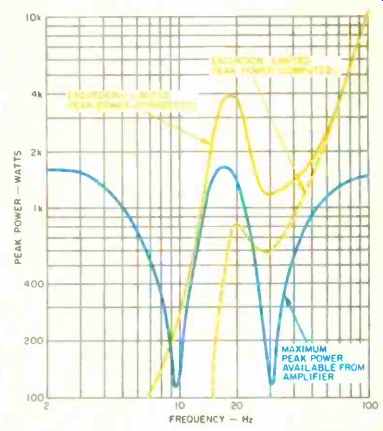
Fig. 4--Permissible peak power input, limited by driver excursion capabilities,
compared to maximum peak power available from the amplifier, as functions
of frequency. Both excursion limited curves are computed, not measured; the
corrected curve includes the effects of increasing radiation resistance at
low frequencies. The amplifier is rated to deliver 800 watts into 4 ohms;
the curve shows power available into the impedance actually presented by
the speaker at each frequency.
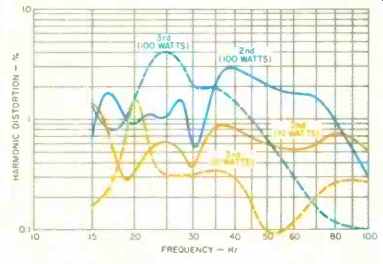
Fig. 5--Main harmonic components vs. frequency, for 10- and 100-watt inputs.
The 100-watt curves have been lowered 10 dB for clarity.
Listening Evaluation
Perception of bass frequencies in small, regularly shaped rooms can be highly variable depending on the listener's location relative to standing waves generated by normal-mode resonances. Normal-mode resonances of a room may be calculated from:

...
where C is sound velocity in air; L, W, and H are room dimensions, and m, n, and o take on all positive integers [1]. A large number of closely spaced resonances is desirable, as they will smooth the overall room response rather than appear as individual resonances. As my listening room is L-shaped, it has eight pairs of parallel surfaces; thus, for me there are eight factors to the equation instead of three.
The room is 5,800 cubic feet in volume and has a projecting fireplace wall; it should be fairly neutral, as it has 23 normal-mode resonances below 100 Hz, nine below 50 Hz, and four below 30 Hz. The four lowest resonances are rather closely spaced, at 18, 22, 25, and 28 Hz.
All listening was done in this large room, with the subwoofers placed flanking the existing stereo speaker cabinets. The entire system is currently in transition but presently includes the two subwoofers, crossed at 80 Hz into a three-way system that's completely horn-loaded. The system comprises JBL 15-inch mid-bass drivers in exponential horns, JBL 2445 titanium-diaphragm compression drivers (with 2 inch throats and 4-inch voice-coils) in 500-Hz horns, and JBL 2405 diffraction-horn super-tweeters. Additional crossovers are at 700 Hz and 7 kHz.
All four channels are multi-amped via Rane four-way Linkwitz-Riley constant phase crossovers with a slope of 24 dB per octave and adjustable low channel phase-delay compensation.
All eight individual channel gains are set for flat response to wide-band pink noise, as observed on a third-octave analyzer with its microphone at the listening position.
Subjective evaluation of any loudspeaker system is always difficult, as one can never be certain whether what one seems to hear is real or imagined.
With these subwoofers, I am constantly amazed as I listen to familiar recordings and hear additional bass information that I never suspected was present. The bass extension is certainly real and not imagined, as it represents a new or additional sonic experience rather than a changed experience. The lowest organ, drum, and synthesizer tones on recordings are distinctly felt, in an almost unimaginable way, as well as heard. One can actually feel the spaceship departure in the "2001: A Space Odyssey" section of Telarc's Time Warp, as floor and walls rumble and vibrate, yet the bass is neither overpowering nor tiring, as is sometimes the case with subwoofers placed near the corners of relatively small listening rooms.
On first listening, there appeared to be an immediate improvement in the mid-bass and middle frequencies as well as the low bass. What believed heard was a difference in timbre; difficult to describe in words, it may be the expected reduction in amplitude modulation or intermodulation of mid-bass and midrange by the low bass. (In any system without a subwoofer, audible or inaudible bass-cone excursion modulates [10] the remainder of the spectrum radiated from that cone. In most systems, this includes frequencies to 1 kHz or higher, or most of the fundamental musical spectrum.) However, now that I'm used to the system's new sound, I don't hear this improvement as much-was it ever real at all? I can report that it did seem to be real and was immediately apparent upon installation of the subwoofers.
One unexpected, dramatic, and demonstrable difference in sound occurred when I installed the sub woofers. Telarc's digitally mastered LP (DG-10039) and CD (CD-80039) of Stravinsky's "Firebird" paired with Polovtsian dances from Borodin's "Prince Igor" exhibit an unusual buzz on the most dramatic part of the Polovtsian dances. The buzz diminishes neither with changes in tracking force nor with listening level, and it was initially disconcerting. I later accepted the buzz as part of the music, particularly when Telarc's Jack Renner assured me that the buzz near four minutes into track three of the CD "is real, is a bass tuba, and is a particularly raspy bass tuba, at that." Eventually, I came to like the sound of the raspy bass tuba. With the addition of the subwoofers, the rasp has disappeared, either because of reduced distortion or increased fundamental presence. Point made, but I rather miss the raspy sound.
The dynamics of the music are improved with the addition of the lower octave and the cleaner reproduction of the mid-bass to midrange. A larger soundstage appears, possibly due as much to the visual effect as to the mirroring of the mid-bass speakers in the subwoofer cabinetry. I recommend that you try subwoofers like these if you want all the music and have the space to spare; you'll like them.
References
1. Fielder, Louis D. and Eric M. Benjamin, "Subwoofer Performance for Accurate Reproduction of Music," Journal of the Audio Engineering Society, Vol. 36, No. 6, June 1988.
2. Small, Richard H., "Vented-Box Loudspeaker Systems, Part II: Large Signal Analysis," JAES, Vol. 21, No. 7, July/August 1973.
3. Small, Richard H., "Vented-Box Loudspeaker Systems, Part I: Small Signal Analysis," JAES, Vol. 21, No. 6, June 1973.
4. Thiele, A. N., "Loudspeakers in Vented Boxes, Part II," JAES, Vol. 19, No. 6, June 1971.
5. Thiele, A. N., "Loudspeakers in Vented Boxes, Part I," JAES, Vol. 19, No. 5, May 1971.
6. "VBOXRES," a computer program by Jeffrey E. Bollinger with additions by Rollins Brook of BBN Laboratories and Drew Daniels of JBL Professional, based on algorithms developed by Don Keele at JBL and further modified to include variable Ob (the ratio of acoustic mass resistance to series acoustic resistance of the vent at the box resonant frequency) with cabinet volume.
7. Allison, Roy F., "The Influence of Room Boundaries on Loudspeaker Power Output," JAES, Vol. 22, No. 6, June 1974.
8. Jacobsen, Oluf, "Some Aspects of the Self and Mutual Radiation Impedance Concept with Respect to Loudspeakers," JAES, Vol. 24, No. 3, March 1976.
9. Clark, David L., "Velodyne ULD15 Powered Subwoofer," Audio, November 1987.
10. Klipsch, Paul W., "Modulation Distortion in Loudspeakers: Part II and Part Ill," JAES, Vol. 18, No. 2, February 1970 and Vol. 20, No. 10, December 1972.
(adapted from Audio magazine, Jan. 1990)
Also see: The Audio Interview: Laurie Fincham--bass viol to bass driver (Jan. 1990)
= = = =